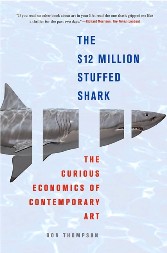
Don Thompson, a teacher of marketing and economics at York University in Toronto, started studying art auctions because he didn’t quite understand how they work. “My friends ask, ‘Why is this being sold, and why at these prices?’ And I say, ‘I don’t know,’” he said. “Who determines the one-tenth of one percent of artists who get to earn money like that?” Thompson, author of The $12 Million Stuffed Shark: The Curious Economics of Contemporary Art, explained why art costs so much, what it means to brand an artist, and how high art prices are changing the way the we see and make art.
Q. What’s the story behind the $12 million shark? How did it end up costing that much, and is it worth it?
A. The shark was dreamt up by Damien Hirst and a friend over a beer in London in 1990. At that point, it was happily swimming somewhere near Australia. They phoned Australia and asked if someone could catch a shark for them. So fisherman got one in 1991, packed it in ice, and shipped it to England, where it was pumped full of preservatives, mounted in a tank, and titled by Hirst, “The Physical Impossibility of Death in the Mind of Someone Living.” It was said by Hirst to represent the border between life and death-the shark looks alive, and is dead, and when you stand in front of it, you remember by what a thin thread your own life hangs. Particularly with Hirst, the branding is in the title. If he had named it “Shark,” we’d all say, “Yup, that’s a shark. It seems to be dead, in a tank.” The title gets you thinking. It was sold as a work of conceptual art to British collector Charles Saatchi for 50,000 pounds in 2002. That was the second highest price ever achieved by a living artist at the time, topped only by Jasper Johns. That’s incredible. The artists who bring high prices tend to be dead or shortly will be dead.
 In January 2005, the shark was resold for $12 million. Both of these prices were very high publicized, obviously leaked to the press. Of course art is one of those things where both parties have a motive to exaggerate the price – the artist can exaggerate his worth and the buyer can exaggerate his wealth. Did it actually sell for $12 million? It’s the accepted American number. In any case, it’s a spectacular price for a shark. And the shark was deteriorating. It had been stored since purchase – its scales were falling off, a fin had become detached, and it just looked pathetic. So Hirst agreed to replace it. That’s interesting too. If I were to repaint an old Rembrandt you probably wouldn’t think much of it. But a work of symbolic contemporary art, you can replace. The work on loan to the Metropolitan Museum of Art right now is a replacement, and it is also deteriorating – you can see discoloration in the water and the shark. So not only was it expensive, but it had a short life. The top one percent of the art market is a parallel, very different universe.
In January 2005, the shark was resold for $12 million. Both of these prices were very high publicized, obviously leaked to the press. Of course art is one of those things where both parties have a motive to exaggerate the price – the artist can exaggerate his worth and the buyer can exaggerate his wealth. Did it actually sell for $12 million? It’s the accepted American number. In any case, it’s a spectacular price for a shark. And the shark was deteriorating. It had been stored since purchase – its scales were falling off, a fin had become detached, and it just looked pathetic. So Hirst agreed to replace it. That’s interesting too. If I were to repaint an old Rembrandt you probably wouldn’t think much of it. But a work of symbolic contemporary art, you can replace. The work on loan to the Metropolitan Museum of Art right now is a replacement, and it is also deteriorating – you can see discoloration in the water and the shark. So not only was it expensive, but it had a short life. The top one percent of the art market is a parallel, very different universe.
Q. How does art get branded, and how has this process changed since earlier last century?
A. You think of branding in terms of Coca Cola, or at a higher level, of Louis Vuitton, or Prada, or the Hermes Berkin bag. Ask yourself, why does a woman pay $8,000 for a bag when she can buy one of equal quality for a third of the price? You know the answer – the bag says, “I am a woman of taste and wealth.” The same thing happens when you hang a Hirst painting on the wall, especially one you bought at a Sotheby’s evening auction. That’s a double brand, and by definition it must be a work of art, and you must be a person of culture and money, and no one can challenge that. Think of George Clooney in “Up in the Air” – would you have seen it if he hadn’t been in it? The brand replaces the artistic judgment of an object. You go see “Up in the Air”, you buy a Warhol.
The other characteristic of branding in art is prizing innovation and originality over content. An artist named Felix Gonzalez-Torres made sculptures out of candy. When you bought it, you got a packing crate of candy and you piled it in the corner. You paid several hundred thousands of dollars for it. He was a New York artist in the 1990s whose lover contracted AIDS, and who died very painfully over two years. So Gonzalez-Torres made these sculptures, weighing in at the combined weight of him and his lover before they got ill. If you bought the piece, you would eat the candy, and as the sculpture declined, it was conceptually the wasting away of the artist and his lover. At some point you could renew life by buying more candy. Now if you paid six figures for candy in a corner, your friends would question your sanity. But if you bought it at Christie’s, they might not.
Q. How would you define contemporary art, and is it always considered strange in its time?
A. I don’t know whether it is different. In the late 19th century, the impressionists were regarded as crazy because of the way they used color. One of the aspects of branding is, you have branded art and branded dealers and branded collectors. One of the ways to determine what contemporary art is is to consider how a new dealer becomes a brand. How does he become a Gagosian? One way is to establish a position in a new kind of art – there is an incentive for dealers to get innovative, and prize originality over content. Ninety-five percent of them will fail. But if you try to go up against Gagosian, you will definitely fail. Any sensible artist choosing between you or me or Gagosian would go Gagosian. Still, 80 percent of artists being shown in Los Angeles today will not be shown in Los Angeles 10 years from now. There is a turnover and an evolution. So if you buy aret, you better buy what you love, because it’s not necessarily a good investment.
There’s a branding story in the book about A.A. Gill, the restaurant and food critic for the Sunday Times London. When he was at college at Cambridge he bought on a whim a portrait of Stalin, by a communist artist, which he hung over his desk. That was a dangerous thing to do – he explained it by saying “Uncle Joe reminds me to be diligent and work harder.” He also hung it over his desk at the Times until he decided to try to sell it to Christie’s. They said, “We do not handle works of Stalin or Hitler.” He said, “If this were by Damien Hirst, would you handle it?” They said, “Of course, but it’s not.” Gill called Hirst, who he knew, and Hirst agreed to take a look at the portrait. He took a red marking pen off Gill’s desk and drew an off-center nose on Joseph Stalin and signed it. Christie’s then said they would pay up to 20,000 pounds for it. It sold for 140,000 pounds. That’s the ultimate branding story.
Q. How has the high end of the art market changed the way most people consume and understand art?
 A. High-end galleries try to be exclusive. If you look at I.M. Chait Gallery in Los Angeles, you see people walk up to the door and stand there, and then they walk away. There is a psychological barrier, and the gallery intends it. The woman who greets you is meant to ask, “Can I help you?” in a tone that makes your hair stand up. She is taught to recognize women with fake purses, to turn away women in groups of three or more, to turn away artists who want to meet the gallery owner. She doesn’t need to know about art, but she needs to know how to be exclusive. I don’t know how many people go to evening auctions, but if you go to high-end auctions in London you need a ticket. That’s another barrier. And then of course there’s the prices, which make the prices at your local gallery at the end of the street seem pretty reasonable.
A. High-end galleries try to be exclusive. If you look at I.M. Chait Gallery in Los Angeles, you see people walk up to the door and stand there, and then they walk away. There is a psychological barrier, and the gallery intends it. The woman who greets you is meant to ask, “Can I help you?” in a tone that makes your hair stand up. She is taught to recognize women with fake purses, to turn away women in groups of three or more, to turn away artists who want to meet the gallery owner. She doesn’t need to know about art, but she needs to know how to be exclusive. I don’t know how many people go to evening auctions, but if you go to high-end auctions in London you need a ticket. That’s another barrier. And then of course there’s the prices, which make the prices at your local gallery at the end of the street seem pretty reasonable.
Other than that, I’m not sure how much of this market influences the art you buy or the prices you pay. But it does make good gossip. There are only two institutions in the world whose prices are reported by virtually every newspaper even though the average reader will never shop for that item. The first is the stock market and the second is record-setting art prices. The auction houses are phenomenal promoters.
Q. Has it changed what art is made?
A. That’s hard to say. Being a professional artist may be the worst profession in the world. Writing novels is up there too. There must be 40,000 artists in New York and 40,000 in London and of that number maybe 500 in each city are making a decent living. And 15 percent of those will turn over each year and get replaced. They’ll try for two years and live eight to a room and share studios, and then they’ll move on. Artists in art schools are probably influenced by what they see selling at major galleries, or maybe what they are taught is influenced by what sells, but I don’t know.
*Photo of Hirst’s work courtesy william_hines.




Send A Letter To the Editors